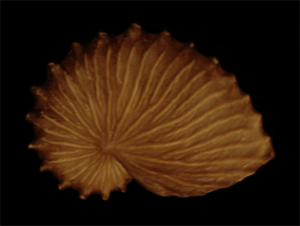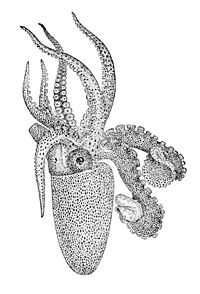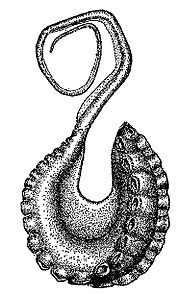Böttger's argonaut facts for kids
Quick facts for kids Böttger's argonaut |
|
|---|---|
 |
|
| Eggcase of Argonauta bottgeri | |
| Scientific classification | |
| Synonyms | |
|
Argonauta boettgeri orth. var. |
The Böttger's argonaut, also known as Argonauta bottgeri, is a special type of octopus. It lives in the open ocean, far from the coast. This animal belongs to a group called argonauts.
Female argonauts are famous for making a beautiful, thin shell. It's often called a "paper nautilus" because it looks like a nautilus shell. This shell is actually an eggcase. The female octopus carries her eggs inside it.
Contents
Discover the Böttger's Argonaut
The Böttger's argonaut is the smallest known argonaut species. Its eggcase is usually less than 50 millimeters (about 2 inches) wide. Some rare ones can be a bit larger, up to 67 millimeters.
What Makes Its Eggcase Special?
The eggcase of the Böttger's argonaut has some unique features. It has clear ribs and bumps along its edge. Unlike some other argonauts, its eggcase does not have wing-like parts.
The color of its eggcase can be quite dark. It ranges from yellow-brown to almost black. However, some white eggcases have been found near South Africa. The surface of the eggcase feels a bit grainy. It usually doesn't have the shiny, smooth look of other argonaut shells.
Where Do Böttger's Argonauts Live?
You can find Böttger's argonauts mostly in the waters around southern and eastern Africa. They also live in other parts of the Indian Ocean and the western Pacific Ocean. The first place where this species was officially found was Mozambique.
What Do Argonauts Eat?
Böttger's argonauts mainly eat other small sea creatures. They especially like molluscs that float in the open ocean. These include tiny snails called heteropods and pteropods. Sometimes, they also eat other small octopuses. For example, female argonauts in Japan have been seen eating a type of pteropod called Carolina tridentata.
Who Eats the Argonauts?
Many animals prey on the Böttger's argonaut. For instance, they have been found in the stomachs of yellowfin tuna in the Indian Ocean.
Life Cycle of the Böttger's Argonaut
Male Böttger's argonauts are quite small. They reach their full size, about 7 millimeters long, when they are ready to reproduce. Females start making their eggcases when they are about 6.5 to 7 millimeters long.
Females lay their eggs when they are around 14 or 15 millimeters long. However, the exact size can vary depending on where they live. They mature at about half the size of a larger argonaut species, Argonauta argo.
How Eggs Develop
The eggs inside the argonaut's eggcase are laid in groups. These groups show different stages of development.
- The eggs closest to the opening of the eggcase are the newest.
- The eggs in the middle are a bit older. You can start to see their eyes and color cells (chromatophores).
- The eggs furthest inside are almost ready to hatch. These baby argonauts have fully formed ink sacs, color cells, and dark eyes.
Scientists think that females lay eggs over several nights. Each night's eggs might form a new group with a different development stage.
Interesting Behaviors
Böttger's argonauts are known to hold onto things floating in the ocean. This includes other argonauts! Sometimes, you can see long chains of up to 30 argonauts. They are all similar in size. The first argonaut in the chain usually holds onto something like a piece of wood. Then, the other argonauts hold onto the shell of the one in front of them.
Naming the Argonaut
The Böttger's argonaut is named after a person called Oskar Boettger. You might sometimes see its name spelled as "Argonauta boettgeri". This is just a different way of spelling the same name.



